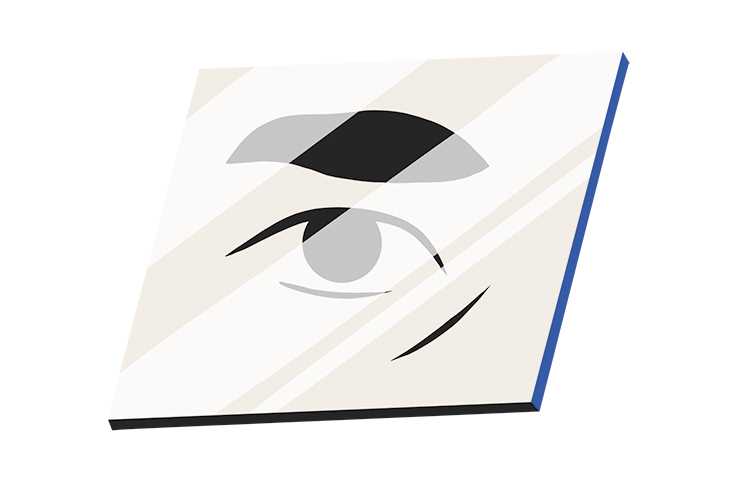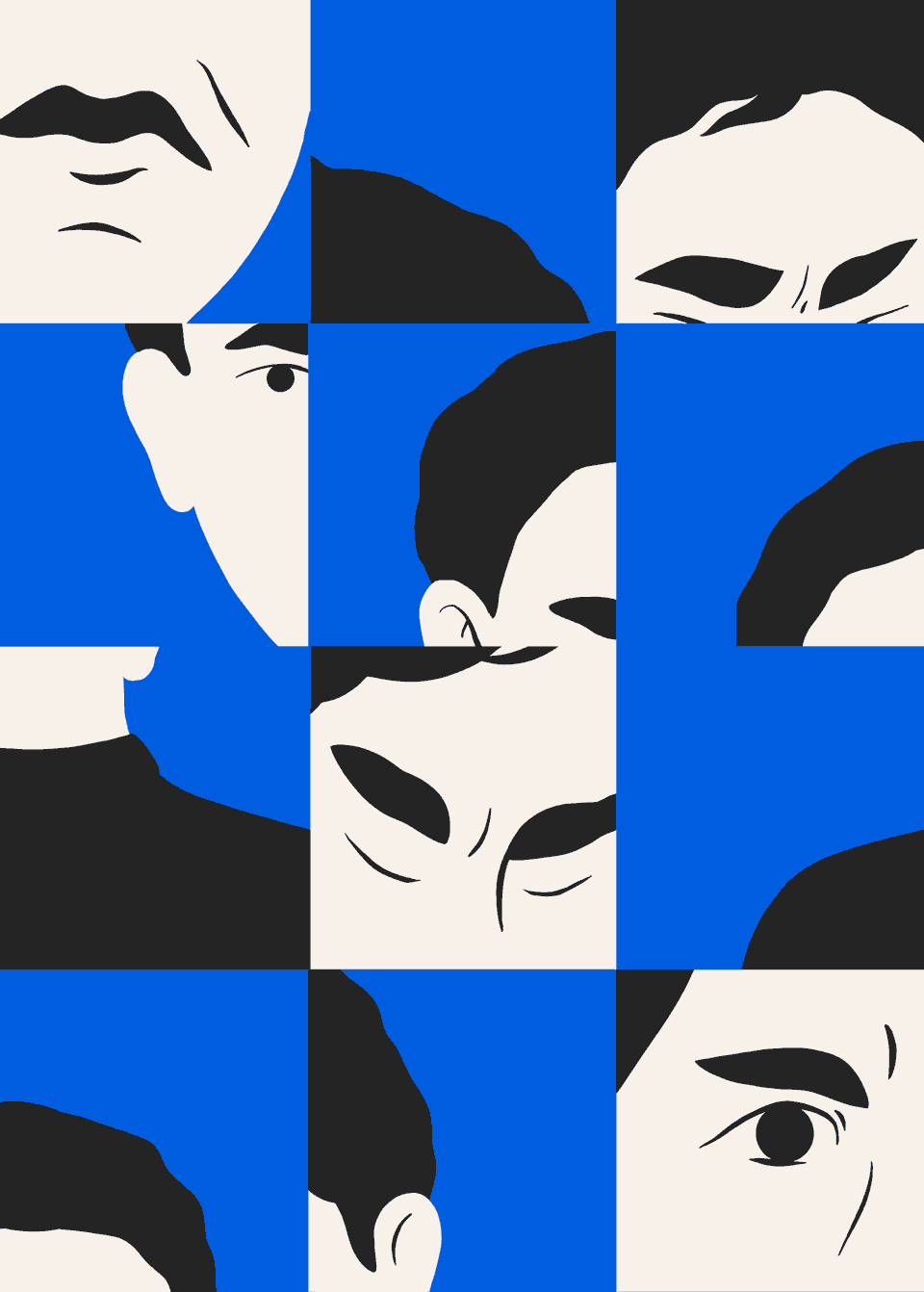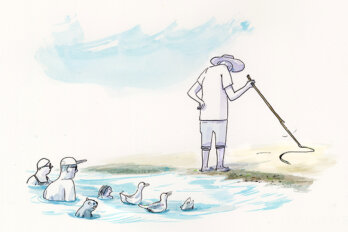One late spring day when I was ten, I sat in my sixth-grade class and felt a dull tingle throughout my head. I remember beginning to panic. My eyes darted around to see if anyone else had noticed that something was happening to me. It was a sunny afternoon, and the class was drowsy. Thankfully, the other students were slumped in their chairs, eyes toward the front but minds wandering.
I fled the classroom, hiding just outside the door. My head cocked at a slight angle as the shaking began. With each twitch, I repeated a lie: this is the last one this is the last one this is the last one. The storm inside my head eventually subsided; the shaking stopped. I returned to my desk with a dull headache.
It had been a year since the impulses had started, gentle at first and then unmistakable. Every few minutes or so, a sensation originating from somewhere in the back of my brain would order my head to jerk from side to side. Each shake brought momentary relief, like scratching an itch. Moments later, though, the urge would return.
Since the impulses first appeared, around twenty-five years ago, I’ve learned that stress makes them worse while exercise eases them. On a good day, for a few minutes, I can hold them back by tensing the muscles in my neck until they feel as though they’re vibrating. If I don’t give in to the urges, my head feels like the rattling lid on a pot of boiling water. Trying to resist isn’t only emotionally draining—it hurts. Days of straining and tensing my neck often leave me sore and frustrated.
In public, my head sometimes shakes back and forth as if in disagreement. As a journalist trying to come across as empathetic during interviews, I instead seem skeptical. My eyes twitch as though it’s been weeks since I had a good night’s sleep. The urges come in waves: sometimes as a frenzy of tics, most of the time as an occasional blip every few hours. I have a constant urge to sniffle and, at other times, to clear my throat. Despite what felt like an uneasy truce with my brain for much of my life, a new tic has appeared in recent years: stretching my neck forward while contracting my shoulder blades, which makes me appear deferential, as if I’m politely nodding to passersby. My tics are so frequent that I don’t realize they’re happening until I see a video of myself; it’s part of the reason I’m hesitant to go on camera as a reporter.
I’ve spent much of my adult life doing what I loved as a child: asking questions in the hope of finding some sort of resolution. Despite being someone who obsessed over the smallest questions and problems in the world around me, I long resisted turning those skills inward. As a result, I never knew the source of my tics, never knew that I had been living with Tourette’s syndrome.
The deep waters of Moosehead Lake lie within a valley formed by Maine’s Longfellow Mountains, themselves part of the broader Appalachian Mountains. Blanketing much of the region are thick forests of pine and birch. It was in these woods, in the late nineteenth century, that residents first spotted the mysterious phenomenon of the Jumping Frenchmen of Maine.
A number of French Canadian lumberjacks were known to jump or shout when startled, their limbs seizing as if they had been electrocuted. In 1880, George Miller Beard, an American neurologist, travelled to the woods to investigate the men. When he met them, he marvelled that, no matter how hard the men tried to suppress their responses, their bodies overrode any protest. In an 1880 edition of Popular Science Monthly, Beard wrote, “While sitting in a chair, with a knife in his hand, with which he was about to cut his tobacco, he was struck sharply on the shoulder, and told to ‘throw it.’ Almost as quick as the explosion of a pistol, he threw the knife, and it stuck in a beam opposite; at the same time he repeated the order ‘throw it’ with a certain cry as of terror or alarm.” The behaviour naturally led to practical jokes among the woodsmen, Robert Pike recounts in his history of logging in the region, Tall Trees, Tough Men: “The men would wait until [a cook] was about to place a dish of soup or some other spilly food on the table and then say, ‘Drop it!’ and down it would come, right down the neck of the nearest man.”
The case joined other curious tales of the era that highlighted the impenetrable mysteries of the brain. In Malaysia and Indonesia, some people displayed a startling condition called latah. In Siberia, there was a condition called miryachit; in Japan, another called imu. Conditions like these fascinated a French medical student and his mentor. An eager pupil in his twenties, Georges Gilles de la Tourette was training at the Salpêtrière, a bustling teaching hospital in Paris, under the guidance of Jean-Martin Charcot, a preeminent figure in the burgeoning field of modern neurology. With Charcot’s encouragement, Gilles de la Tourette began compiling tales and reports of “chorea,” a catch-all term at the time used to describe disorders characterized by jerky, unpredictable movements.
Bodily tics were believed to have been first documented in The Hammer of Witches, a fifteenth-century book that describes, among its anthology of witchcraft and demonic possessions, a priest whose abnormal tongue movements, vocal tics, and coprolalia, or calling out inappropriate words and sounds, were believed to be the work of the devil. “When he passed any church, and genuflected in honour of the Glorious Virgin, the devil made him thrust his tongue far out of his mouth,” the book recounts, “and when he was asked whether he could not restrain himself from doing this, he answered: ‘I cannot help myself at all, for so he uses all my limbs and organs, my neck, my tongue, and my lungs, whenever he pleases causing me to speak or to cry out . . . and when I try to engage in prayer he attacks me more violently, thrusting out my tongue.’”
There have been countless examples of tic conditions misunderstood throughout history. Eighteenth-century poet and essayist Samuel Johnson was once described “standing at a window in the room, shaking his head, rolling himself about in a strange ridiculous manner.” Johnson was one of the most brilliant minds in the English language, but the person observing him concluded that he was “an idiot.” In the annals of neurology, the condition’s most famous case study was a woman known as Marquise de Dampierre, who shouted profanities when she tried to speak. Her behaviour was first documented in 1825 by Jean Marc Gaspard Itard but was made famous by Charcot and Gilles de la Tourette, neither of whom ever met her. The outbursts from the “cursing Marquise,” as she was once called, were so consuming that she became a recluse until she died, in her eighties.
By 1885, Gilles de la Tourette had cobbled together nine examples. He theorized that the various cases—including the Jumping Frenchmen—were threads of a single “nervous illness”: an illness of tics. In every instance, those afflicted were overcome by a compulsion to mimic, shout, or jerk their limbs. He believed that the condition worsened over time and that it was heritable.
Charcot, to honour his student’s breakthrough, dubbed the condition “la maladie des tics de Gilles de la Tourette.” Instead of being met with a wave of excitement from the medical community, Gilles de la Tourette’s novel illness of the brain was largely ignored. The newly catalogued condition was forgotten for nearly a century. But his paper bore a grim warning: there was no cure for the syndrome, he wrote, because, “once a ticcer, always a ticcer.”
In my teens, I often craved being alone so I could shake and twitch freely, without judgment. Those years were when my tics would wrest control of me. Each tic I gave in to felt like a failure of willpower. I spent years confused. The effects of Tourette’s syndrome can manifest along a spectrum from a debilitating condition of jerks and shouts to a relatively muted form of subtle twitches. On rare, stressful occasions, the tics would take over and my head would twitch back and forth, met only by a painfully polite silence. For most of my life, my tics never materialized strongly enough to merit a visit to a specialist.
“I just thought they were nervous tremors and would go away eventually,” my mom said recently, after I asked when my parents had first noticed something. Someone whose son had Tourette’s once approached her and suggested that I also had the syndrome. But, to my parents, my behaviour looked nothing like that of this other child. “We just didn’t have the information available to us,” my mom told me. “We just saw you as our kid,” my dad chimed in. Their answers felt deeply comforting. They did what parents do: they loved and raised me not because of—or in spite of—anything. I got to be me.
In frantic moments, I felt willing to bargain nearly anything to make the tics disappear.
Tourette’s tics often begin to appear in children around the age of six, with an urge to blink or to move. These are called premonitory urges, and they’re a “false signal” in the brain, says Tamara Milka Pringsheim, a professor of neurology at the University of Calgary who has seen more than 4,000 patients with Tourette’s over her career. “When you feel the urge to blink, it’s saying there’s something wrong with your eyes. It’s like the itch that precedes the scratch.” The head then feels an urge to shake. The shoulders then need to shrug. The nose wrinkles. The lips are licked. Sometimes, the need for one tic to follow another emerges. Tourette’s has a motor component (for me, my head and my eyes) and a vocal part (my sniffling and throat clearing). The tics crescendo between the ages of ten and twelve, making Tourette’s a particularly cruel affliction during a time when children, on the verge of adolescence, are often hyperconscious of their awkward bodies.
The condition has long been deployed in popular media as a cheap comedic device. In the movie 500 Days of Summer, for example, Joseph Gordon-Levitt and Zooey Deschanel take turns shouting “penis” louder and louder, blaming a fictional case of Tourette’s after getting dirty looks. While coprolalia affects approximately 10 percent of people with Tourette’s, the symptom has come to represent the condition. In 2019, journalist Chuck Todd mocked Donald Trump by saying he “tweets like a Tourette’s.” “I sometimes think we should change the name of the disorder,” Pringsheim says. “Maybe something like ‘chronic tic disorder,’ because parents don’t want me to even say the word Tourette’s. It has such a connotation.”
While nearly a century and a half has passed since Gilles de la Tourette first wrote about tics, our understanding of what causes the syndrome is still murky. Experts suspect an error somewhere deep in the regions of the brain that control behavioural responses. Neuroscientists have speculated that the basal ganglia, which contributes to motor control, could be causing a dysregulation of dopamine, a neurotransmitter associated with pleasure and movement. While scientists have identified a gene that causes 1 percent of Tourette’s cases, the causes of the vast majority of cases remain unknown.
“The simple explanation is that we don’t know what’s really happening or why,” Pringsheim says. What’s more, the syndrome often comes packaged with a parallel neurological condition, most commonly OCD or, in my case, ADHD.
A large hurdle for researchers is that there is no animal model to work with. We can’t dissect rats or pigs or monkeys to study Tourette’s inside their brains: the condition is believed to exclusively affect humans.
My wife recalls, on one of our first dates during our final year of university, noticing that I did something with my head, but it never gave her pause. “I don’t think I stopped to think about what it was,” she told me recently. “When you would shake your head, it was like you were thinking in an intense way, that it would make your head twitch.”
For most of our relationship, I rarely acknowledged my tics. If I didn’t draw attention to them, I thought, others might not notice. The ignorance was by design: not knowing their cause meant not pathologizing them into an incurable condition, not knowing what limits might exist with them. But, on the worst days, the tics were a burden that left me aggravated, exhausted, and in despair. What was so wrong with my head that I couldn’t stop? In frantic moments, I felt willing to bargain nearly anything to make the tics disappear. I recently asked my wife if she thought that not knowing their cause, living free of any label, had been good for me.
She paused. “No,” she said. “You love answers.”
An appointment with my family doctor led to a CT scan, then an appointment with a neurologist, then another referral. Which is how, on a grey January morning in 2019, three months before my thirty-first birthday, my wife and I came to be sitting in a small third-floor office at Toronto Western Hospital. I remember the psychiatrist gently asking me to explain the jerky movements, the compulsions, and the irritations I had felt since I was a kid.
“I’ve heard some people describe it as—”
“Tell me how you would describe it,” he said.
As I struggled to explain the feelings in my head, I realized that I had never really spoken about them at length. The psychiatrist provided a confirmation: for the majority of my life, I had been living with Tourette’s syndrome. The source of frenetic energy that had long flowed through my brain and body, spilling into a flurry of unwelcome movements, finally had a name.
Gilles de la Tourette’s final years were marred by tragedy. He largely abandoned any study into tic disorders, instead researching hysteria and hypnosis with Charcot. In 1893, he was shot by a former patient. He miraculously survived, but his behaviour became increasingly erratic, likely the effect of syphilis. Eight years after the attempt on his life, Gilles de la Tourette travelled to Switzerland with his family and Jean-Baptiste Charcot, the son of his mentor. Jean-Baptiste convinced him that a famous patient in an asylum in Lausanne needed his help. Gilles de la Tourette agreed to visit the asylum and ended up locked in one of its rooms, where he remained until his death, at forty-seven.
For someone whose name has come to define a disorder, Gilles de la Tourette published only a single paper on the condition. Experts now agree that, of the nine case studies Gilles de la Tourette used to illustrate the condition, at least five were most likely not Tourette’s syndrome. Some of the earliest purportedly authoritative cases of the condition were misunderstood, and the man whose name became synonymous with the condition died knowing little about it.
A century later, Oliver Sacks, a physician and writer known for transforming dull texts into bestselling case studies, revived interest in Tourette’s. Sacks chronicled his time with “Witty Ticcy Ray,” a twenty-four-year-old man suffering from an extreme manifestation of the condition. It was the first time Sacks had interacted with someone with Tourette’s. He wrote that, in the 1970s, it was believed to affect one in a million people. The day after Sacks met Ray, he saw three others with Tourette’s-like symptoms on the streets of New York. “I was thrown into a turmoil of bewilderment and wonder: was it possible that I had been overlooking this all the time, either not seeing such patients or vaguely dismissing them as ‘nervous,’ ‘cracked,’ ‘twitchy’?” he wrote in a 1981 article. “Was it possible that everyone had been overlooking them? Was it possible that Tourette’s was not a rarity, but rather common—a thousand times more common, say, than previously supposed?”

As his research into Tourette’s progressed, Sacks corresponded with Alexander Luria, a Soviet neuropsychologist. In one of Luria’s final letters, he praised Sacks’s work and declared that a breakthrough in understanding Tourette’s would “vastly broaden” our understanding of human nature. “I know of no other syndrome of comparable interest,” Luria wrote. Sacks’s fascination with the condition and his profound sense of empathy stand in stark contrast to Gilles de la Tourette and his peers, who were convinced that anyone with a disorder of the mind displayed a weakness of virtue —one inherited from the previous generation. To them, tics were a moral punishment handed down from parent to child.
Our son was born on a late spring evening in 2021. There was little time to comprehend the immensity of the event. Midwives rushed around the room. Anxiety gave way to awe, both at my wife’s courage and at the wrinkly, confused face that was our boy. Our world caved in. Time made little sense. We focused on the small things. In the weeks and months that followed, my wife and I hunted for our features in him: he had her eyes, my lips, her ears, my forehead. He has a birthmark, a faint red patch sprinkled along his neck, something he shares with his maternal aunts, grandfather, and great-grandfather.
Some days, I stared at him while he slept and wondered if there were other things he might have received from me. Much of what we inherit is chance, the collision of potentialities that forms our bodies. But, in other ways, there is a finger pressed on the scale: a distinct nose, it seems, can persist for generations. So can Tourette’s, especially in males. Our boy, because he is my boy, has a high chance of developing at least one tic. As I watched him, the calm on his face was sometimes interrupted by a twitch. I knew it was just his nervous system fine-tuning itself. Still, I couldn’t help but worry that I might have handed my son a design flaw,a manufacturing error.
Months before he was born, when my wife and I scanned family trees in search of possible names, I found myself staring at the branches on my father’s side more intently. Among the scattering of relatives who had lived in the northern Italian countryside, how many had lived with tics? How many shook their heads to rid themselves of a feeling lodged deep in their brains?
For years, I ignored tics displayed by my brothers—movements in their eyes—and by my father—sniffling and head jerking. “It feels like I’m trying to itch the top of my head with my eyes,” said my youngest brother when I asked him what it felt like. My cousin recently told me that she, too, felt the occasional tic sweep over her and that giving in would bring “sudden relief.” These words became clues that I may not be alone.
When I finally asked my father, he shared that he had had similar feelings in his head, when he was a kid, that would often pass unnoticed. It was the first time he’d told me about them. He was never interested in receiving a possible diagnosis despite the likelihood that members of his family would have similar brains. As I told him about my experiences, he surprised me with a piece of his own history: his father had scolded him for rubbing his chin on his shoulder and for his constant sniffling. He had long eked out a truce, in life and in his work as an architect, with the urges in his mind.
Pringsheim tells me it is possible that other members of my family have Tourette’s or another condition of tics. For everyone, she says, there’s a “constellation of genes” at play, a random collection of stars that make up who we are.
The first time I held my son, I finally understood what it meant that something—an assembly of cells, tiny fingers and squinting eyes—could be far more than the sum of its parts.
There is no known cure for Tourette’s, but there are a handful of ways to ease the tics. People can take antipsychotic medications or, in some cases, have electrodes inserted into their brains. Pringsheim has found success injecting Botox into her clients to dim the effects of facial tics. One group of researchers claims that stimulating the median nerve with electrical pulses can reduce tics. A type of behaviour therapy—taking one urge, like the need to shrug the shoulders, and doing the opposite when the urge appears—has also seen success.
For a brief period after my diagnosis, I tried the drug guanfacine. Over a few months, the dosage gradually increased in strength. At first, I was curious to see if a blend of chemicals could do what willpower and frustration and pleading couldn’t: finally excise the urges from my brain. Instead, I just felt more tired, a tad more forgetful. And the tics remained.
My doctor suggested other options, but the failure of the medication brought me back to a predicament that Sacks once raised. He wrote that some people with Tourette’s were “scarcely able to achieve real identity amid the tremendous pressure and chaos of Tourettic impulses.” I can’t remember a life without my tics; they exist faintly in the background of nearly all my memories. But I’ve never felt that they defined me. In trying to treat my tics, was I carefully removing a few strands from a tightly threaded rope—or was I tugging at something that might unravel?
The brutal reality of many degenerative brain diseases is that the person’s sense of self crumbles as the illness takes hold. But, with Tourette’s, despite the misfiring in the brain, the person remains—nothing about them changes. It increasingly felt as though, while there was no loss of self, the condition was able to braid itself into the mind, like a vine twisting around a tree until the two become inseparable. It was a self I saw reflected in my son.
I recently asked my wife what she thought of the prospect that our son will have the condition. “If our kid has Tourette’s, you of all people would be a great parent,” she said, “because you know what it’s like first-hand.” For months, I had fixated on the wrong question. We have no control over what we genetically pass on to our kids. Instead, my wife reminded me of a second, far more meaningful category: the things we choose to pass on. The actions, the gestures, the efforts to show we care about other people.
The other day, as I watched him and he watched the world, I experienced a fleeting moment of sadness. There was a real chance that he might not get it, that the tics might end with me. In a way, it would be as if a thread that connected me to him and to the generations before us had snapped. For all the years I spent resenting the tics, the feeling took me by surprise. His birth had unexpectedly forced me to confront questions I had long ignored. If the thread remains unbroken, however, and if he finds himself in a classroom on a late spring afternoon with strange urges in the back of his head, I can give him what I never had growing up: an answer.





